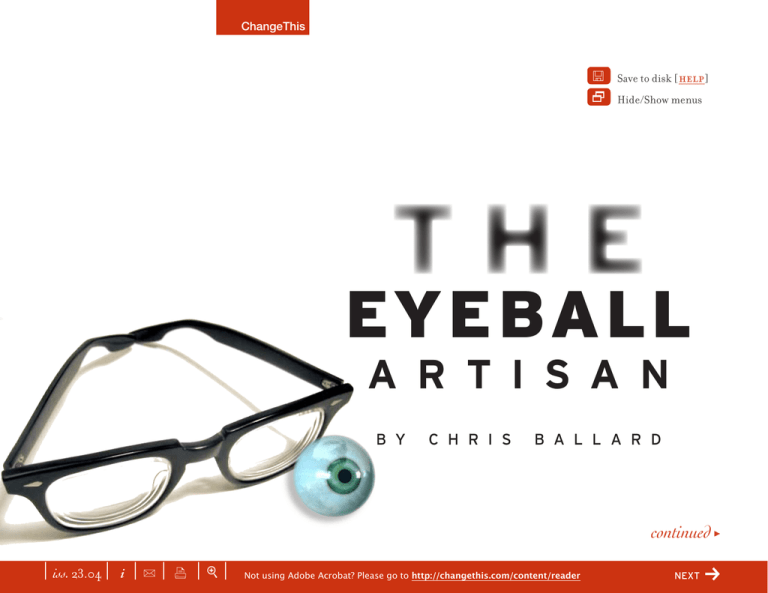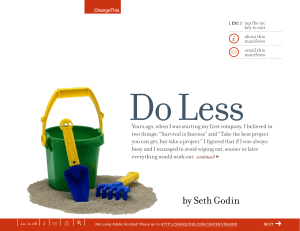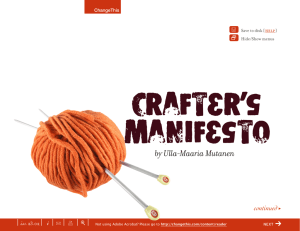
ChangeThis
Y
Save to disk [ help ]
2
Hide/Show menus
The
Eyeball
A r t i s a n
b y
C h r i s
B a l l a r d
continued >
| iss. 23.04 | i | U |
x
|+|
Not using Adobe Acrobat? Please go to http://changethis.com/content/reader
next
f
ChangeThis
I’ve always found it comical when a certain profession is described across the board as a
“dream job,” as if we could all agree upon what constitutes such an ideal. Professional athletes are often said to have dream jobs, but, as someone who covers them on a regular basis
as a staff writer at Sports Illustrated, I can attest to the fact that some of them are among
the most jaded individuals I’ve ever met. Somewhere along the way from passion to profession, they lost touch with the nine-year-old they once were, the one who put on mittens to
go shoot baskets in the winter, retrieving the ball each time from its snow dimple. So we
impugn them when they complain, because they’re being paid millions to play a child’s game,
for God’s sake. They should be the happiest people on the planet, or so the equation goes:
something you love to do plus gobs of money to do it equals happiness.
Excerpted from
The Butterfly Hunter:
Adventures of People Who
Found their True Calling
Way Off the Beaten Path
This math is part of a larger, and it turns out, thoroughly modern, belief that we are supposed
to find happiness through our work. We speak of finding meaningful work, or, more grandly,
a “true calling.” The upshot is that people feel as though they’re expected to find this elusive
calling but—as with the notion of true love—no one’s quite sure exactly what that is.
So what, I wanted to know, makes some people so sure? What is it about the fit between a
job and a person that makes someone consider his work a calling? That’s what I set out to
investigate two years ago, when I went in search of people who loved their work. Not just any
people, though. I wanted to see what I could learn from men and women who are very good
at very unusual jobs.
I was continually surprised by what I found, and not just because I was venturing into some
pretty strange subcultures. I uncovered passion in the unlikeliest of places and wisdom where
I never would have expected. I was astonished at the candor and compassion of many of my
subjects. With that, let me introduce you to Willie Danz, “The Eyeball Artisan.”
***
| iss. 23.04 | i | U |
x
|+|
h
/14
f
ChangeThis
Most of the time, when you ask someone what they do for work, they tell you in a sentence or
two. If they’re particularly proud of their work, or they sell things—especially something they
could get you a great deal on tomorrow—they might produce a business card. That business
card might even have a photo on it.
Then there are people like Willie Danz, whose identity is practically fused with his career.
Here is what happens when you ask Willie what he does for a living.
You (at cocktail party, making small talk): “So, Willie, what do you do for a living?”
Willie (smiling and plunging his hand into his left pocket rather suspiciously): “I’m
glad you asked that!”
You (wondering if he’s going to produce a scary religious pamphlet): “Okay…. “
Willie (holding up an eyeball that looks disconcertingly life-like): “I make these!”
You (taken aback): “What in God’s name is that?”
Willie: “I’m glad you asked!”
Danz uses this trick because were he to say, “I’m an ocularist,” (pronounced ock-u-LAIR-ist),
people would probably assume he was a doctor of some sort. And, although many of his
patients address him as such—perhaps because he wears a white doctor’s coat, has a doctorlike office and acts rather like a doctor—he is not a doctor. And if he said, “I make prostheses,” which is the technical term for the eyes, people might envision him working in a plastic
appendage factory, fashioning fake arms. Then again, if he said he made glass eyes, the
best-known term for the prostheses, it would be incorrect on two counts. First, the prostheses are no longer made of glass, and haven’t been since the 1940s (at least not in the States).
Second, they aren’t actually entire eyeballs, but rather concave acrylic shells that fit on top of
| iss. 23.04 | i | U |
x
|+|
h
/14
f
ChangeThis
the eye muscle—or an implant made to mimic the muscle—sort of like a bike helmet over a
child’s skull.
But the main reason Danz carries around the eyeballs is because he really, really likes to talk
about his work. Even among ocularists, a close-knit community filled with many second- and
third-generation practitioners, he stands out. Not only because he’s one of the most accomplished (though he is) and he makes all manner of unusual eyes for horses, dogs and prisoner
(though he does) but also because he is fifth-generation (one of his distant relatives made
the first glass eye). Some people rebel against the family business; I was curious what made
him so passionate about his.
I first met Danz at 8:30 on a Wednesday morning at his office, on the 22nd floor of an office
building in downtown San Francisco, just up from Union Square. Previously leased by a dentist, the place maintained the hygienic feel of its former tenant; I could picture the ghosts of
nervous preadolescents fidgeting in the waiting area. A friendly 27-year-old named Rachael
sat at a desk in the reception area. Rachael came in three days a week, she told me, mainly to
do filing, billing and, when she had time, extra painting on the prostheses (she was particularly good with the irises). Off of the reception area was a lab room and a patient room, which
had a barber’s chair and two large south-facing windows. The orientation was important,
Danz explained, because to accurately judge the color of the prostheses, indirect light, either
northern or southern exposure, is preferred (“a noonday northern light with slightly overcast
is the absolute best,” he told me, somewhat wistfully).
Handsome in a non-threatening way, Danz looks like he plays a doctor on TV. Though 54
years old, he could pass for a man in his forties; he has a full head of brown hair, which he
keeps impeccably combed, smooth skin and the upbeat manner of someone who just found
a five dollar bill in his pocket. He smiles a lot, has a goofy laugh that he uses to warm up his
patients and speaks in an even, reassuring tone, like an airline pilot pointing out the Grand
Canyon below to your left. Every day, he wears some variation of dress shirt and tie, over
| iss. 23.04 | i | U |
x
|+|
Want to copy and paste parts of this manifesto? Click here for instructions.
h
/14
f
ChangeThis
which he buttons a white lab coat. Ever the professional, he keeps a pack of mints handy—
“good breath is important”—and has a small mirror in his lab so that, before patients arrive,
he can double-check the status of his hair.
But the main reason Danz carries around
the eyeballs is because he really, really
likes to talk about his work.
His has been an illustrious career. Danz estimates he’s made more than 15,000 prostheses
in thirty years in the business. He was president of the American Society of Ocularists and a
charter member of the National Examining Board of Ocularists. In a field that numbers only
170 or so in the United States (and 400 in the world), he is renowned, both for his work and
his family name. He has patients who come from across the country for his services, which
run between $2,000 and $2,400 per prosthesis. (The eyes are covered under “durable medical equipment,’ an insurance heading that includes wheelchairs, prosthetic arms and legs,
oxygen tanks and bedpans, a grouping that many ocularists believe does their ‘artwork’ a
disservice). One woman, a fashion model, flew in from the Philippines to get a Danz eye;
another regularly comes in from Washington D.C. for checkups. Danz’s work is so convincing that nurses at UCSF, where he spends two days a month working with children who have
retinoblastoma, occasionally attempt to dilate the fake eye rather than the real one just prior
to anesthesia. Other patients have a hard time convincing on-lookers that they are indeed
sightless; one woman with two striking green-irised Danz prostheses was accosted for sitting
in the handicapped seat of a bus. After futilely pleading her case, she finally had to remove
her eyes to prove they were fake.
| iss. 23.04 | i | U |
x
|+|
h
/14
f
ChangeThis
On this morning, the first patient was Christina, a woman in her forties receiving her annual
checkup. She’d lost an eye—I couldn’t tell which at first—to glaucoma. Doctors tried numerous surgeries to save it but to no avail. She took a seat in the chair and Danz made small talk
for a couple minutes before picking up a small suction cup-like device.
“Let’s have a look then, shall we?” he said
Then he stuck the suction cup onto her eye and pulled it out.
Earlier in the morning, anticipating this very moment, I had actually spent a couple minutes in
my hotel bathroom, practicing what I hoped was a clinically detached facial expression—lips
pursed, eyebrows slightly raised, nothing to see here. It came in handy.
The woman’s orbital socket was moist and pinkish-white. Imagine if one replaced an eyeball
with an oyster and you’ll get the general idea. It was not disgusting so much as disorienting.
My brain wanted to fill in the missing space with something—without the twin markers of
the eyes, I didn’t know where to focus my attention. Danz, as would be expected, was totally
inured to the sight. By his count, he’s probably peered into around in somewhere in the area
of 30,000 eye sockets during his career. He’s seen so many that they inhabit his sleep. “I had
a dream that I went into the bathroom, looked into the mirror and saw that I’d lost an eye,”
Danz told me at one point. “At first, I was freaked out and thought, “Oh no!” Then I started
looking around in there and trying to figure out how I was going to fit myself.”
Like those who go into medicine, Danz has to be able to view a patient’s anatomy in blueprint
fashion. When I asked him if he was ever bothered by what he saw, he cocked his head for a
moment and thought before answering, “People say, ‘You have to look in eye sockets.’ Well, I
think there can be beauty in an eye socket. If the surgeon was good and there’s good tissue
in there, it can be beautiful.”
| iss. 23.04 | i | U |
x
|+|
h
/14
f
ChangeThis
This comment made me pause. Not only because of its unlikely nature but because of Danz’s
sincerity. It occurred to me that if one were to design a litmus test for whether someone had
found a calling, this could serve as it, in one easy question: do you see beauty in the details
of your work? Certainly, this is easier to do if you’re a florist, or an interior designer or, well,
almost anything other than an ocularist. And even then, it would seem to me much easier to
see the prostheses—the part of the job that could more readily qualify as ‘art’—as beautiful
and maintain a clinical neutrality about the eye sockets. Then again, considering all Danz has
seen and heard, he wouldn’t survive long if he didn’t feel this way. There are innumerable
ways to lose an eye, and most of them, as I learned, are quite ghastly.
If one were to design a litmus test for whether someone
had found a calling, this could serve as it...
Do you see beauty in the details of your work?
The second patient of the day was a good example. Forty-three years old, Brett accompanied
most sentences with a self-conscious staccato laugh. He lost the use of his right eye when
he was five years old while playing with a dart gun in the backyard. When the gun jammed,
he did what children do in such situations: he turned the pistol around and looked down the
barrel to see if he could figure out what was wrong. Then, as he put it, “It went POW!”
He remembers screaming and then running into the kitchen to find his mother, who promptly
passed out upon seeing her son with a dart protruding from his eye socket and blood running down one side of his face. “My poor mother,” he said with a wan smile, “was traumatized
for life.”
| iss. 23.04 | i | U |
x
|+|
Want to find the most buzzworthy manifestos? discover them here.
h
/14
f
ChangeThis
And this is one of the less gory stories. Danz estimates that 40% percent of his patients lose
their vision due to eye disease and tumors, the most common being malignant melanoma
and retinoblastoma, a congenital cancer. Another 5% percent lose them to congenital anomalies such as congenital anoahthealmya, when a child is born without an eye, or congenital
microscopia, when an eye stops developing. The rest are due to what is widely termed
‘trauma.” This includes relatively mundane mishaps such as the female patient who was hit in
the eye when her paramour tried to show her the proper golf backswing and the young man
I met that afternoon who’d been shot in the eye with a BB gun as a 15-year-old (cue a thousand admonishing parents).
Then there are the more unusual cases. Such as the woman who was attacked by a Grizzly
bear on a nature walk in Alaska and, as Danz remembered it, “had a good part of her face
torn off” when the bear moved to protect its cubs. Another woman was walking through a
field when a great horned owl swooped down and landed on her head, clawing at her eyes.
Then there was the local police officer who was playing paintball—‘He got taken out of the
game, called himself safe and lifted up his goggles when—poof!—he got hit in the face,”
explained Danz.
I also heard some truly disturbing, doubt-the-goodness-of-humanity stories. One woman
I met lost the use of an eye when, as a grad student at Penn, she was attacked, raped and
stabbed in the eye. Danz told of a husband who, in a fit of rage, reached in and pulled out
his wife’s eye, then held it up to her face and said, “Look what I did.” Twice, Danz has treated
patients who tore out their own eyes. “Both of them were coming down off drugs,” Danz told
me. “The first guy, his girl had recently broken up with him. The second guy, he felt he’d
developed an evil eye. You know the scripture? Something like, ‘if thine eye offends ye, pluck
it out.’ Well, he did.”
| iss. 23.04 | i | U |
x
|+|
h
/14
f
ChangeThis
It takes a certain type of person to enter a line of work that requires coming into contact,
even if only second-hand, with this type of trauma. Many an aspiring surgeon or ER doctor
has been diverted to private practice upon seeing one too many mangled arms or open chest
cavities. Some are squeamish, others overflow with empathy and are haunted by the specters
of patients past. Months later, I was still disturbed by the stories Danz told (not to mention
apprehensive around golfers). When I relayed the tales to my friends, many recoiled—except
for my brother, who’s an ER doctor. He pushed me for more details. Interesting. Was the
orbital bone damaged? Was there massive hemorrhaging? But, like I said, the normal people
were disgusted.
Danz’s wife, who is a schoolteacher, tried to fill in for her husband once when he broke his
arm but, as she told me, “my stomach doesn’t do so well when you get to the socket.” For
many years Danz hoped that his son Dave would follow him into the business to create a
sixth generation, but he couldn’t deal with the emotional carnage. “I could embrace the paper
work, the lab work and the patients, but when it came to the children, that was my downfall,”
said Dave, who is now in banking. “To see the pain and to constantly hear their stories wore
on me.”
Willie, on the other hand, sees the stories as part of the healing, and his role as that of a
listener. “I tend to just let them talk,” he told me while re-setting his lab in between patients.
“Listen and not be judgmental. Agree, nod. The one thing ocularists provide that doctors
don’t is a chance to unload. Doctors often come in after other people have done a lot of the
prep and are real busy. I really make an effort, and have the time, to let them talk.”
He sees all kinds of patients: lawyers, doctors, politicians, a commercial airline pilot, a federal
judge, the elderly, the homeless. Danz doesn’t just treat humans, either. He’s done eyes for
40 horses, including “Pavo Real,” a show horse owned by Bo Derek that Danz estimates was
| iss. 23.04 | i | U |
x
|+|
h
/14
f
ChangeThis
worth “at least a million,” and four dogs, including a police canine in Reno. He used to work
with patients at the California Medical Facility at Vacaville State Penitentiary. When one of the
convicts escaped and burglarized a house, he lost his prosthesis while fleeing from a second
story window. The police found it and took it to a local ocularist who identified it as a Danz
eye. Danz examined it and remembered the patient; six months later, Danz was on America’s
Most Wanted, explaining the case. Not long after, the thief was apprehended.
“I feel like once I make a prosthesis for someone, I become
part of their life…And they become part of mine.”
Though he generally frowns upon it, Danz has also made unusual eyes by request. So
when a Hispanic woman who’d always had brown prostheses came in asking for “Elizabeth
Taylor eyes,” he went looking through magazines to make them for her. He’s made a Harley
Davidson eye for a biker, an American flag eye for a veteran, a 24-karat gold skull for a guy
with an eye patch, and, once, a yellow-and-green cat eye for a guy whose nickname was
“Cat.” One patient kept showing up and his good eye was bloodshot. “He finally admitted he
was smoking a lot of grass,” Danz said, chuckling. “I asked him if he was going to quit and he
said no. So I had no choice but to make him a stoned prosthesis with extra blood vessels. I
said, ‘If you ever quit the habit, let me know and I can take them out.’”
During my two days in the office I met, among others: a peppy 14-year-old skateboarder
who was born without one eye; a 19-year-old deaf boy who’d been coming in since he was
three months old; Claudette, an African-American Pentecostal minister who, prior to coming
| iss. 23.04 | i | U |
x
|+|
Be bold. Dream up your own manifesto and submit your idea here.
h 10/14 f
ChangeThis
into the office, had been preaching enthusiastically, unaware that she’d put in her eye upside
down (the parishioners, Claudette recounted, thought she’d really channelled the holy spirit
on that day); and John, who’d been coming in since 1977, when he’d lost an eye to shards of
glass in an auto accident. Danz greeted each like a friend. With the help of a Polaroid—he
snaps one of every patient—he says he can remember almost everyone he’s ever worked on.
“I feel like once I make a prosthesis for someone, I become part of their life,” he told me in a
rare moment of emotional analysis. “And they become part of mine.”
Copyright © 2006 by Chris Ballard.
From the book THE BUTTERFLY HUNTER by Chris Ballard, published by Broadway Books, a division
of Random House, Inc. Reprinted with permission.
| iss. 23.04 | i | U |
x
|+|
h
11/14
f
ChangeThis
info
About the Author
After a string of oddball jobs, Chris Ballard found his calling at Sports Illustrated as a staff writer covering the NBA and writing features. He has written profiles of people with offbeat professions for the
New York Times Magazine and is the author of Hoops Nation, which was named one of Booklist’s Top Ten
Sports Books of 1998. Ballard recently moved from New York City to Berkeley, California.
download this
This manifesto is available from http://changethis.com/23.EyeballArtisan
send this Click here to pass along a copy of this manifesto to others.
http://changethis.com/23.EyeballArtisan/email
Subscribe
Learn about our latest manifestos as soon as they are available. Sign up for our free newsletter and
be notified by email. http://changethis.com/subscribe
z
| iss. 23.04 | i | U |
x
|+|
last page read
| more
f
h 12/14 f
ChangeThis
info
WHAT YOU CAN DO
You are given the unlimited right to print this manifesto and to distribute it electronically (via email,
your website, or any other means). You can print out pages and put them in your favorite coffee shop’s
windows or your doctor’s waiting room. You can transcribe the author’s words onto the sidewalk, or
you can hand out copies to everyone you meet. You may not alter this manifesto in any way, though,
and you may not charge for it.
Navigation & User Tips Move around this manifesto by using your keyboard arrow keys or click on the right arrow ( f ) for
the next page and the left arrow ( h ). To send this by email, just click on
U
.
Having problems saving to disk? First, make sure you have the latest version of Acrobat Reader 6 which you can download from
http://www.adobe.com/products/acrobat/readstep2.html. If problems persist, it may be due to your
Acrobat Reader settings. To correct the problem (for Windows), a reader, J. Hansen, suggests going
to your Acrobat Reader Preferences > Options > Web browser Options. Check the “Display PDF in
Browser” option. Then click on Save to Disk
Y
.
keyboard shortcuts
pc
mac
Zoom in (Larger view)
[ ctl ] [ + ] [
Full screen/Normal screen view
[ ctl ] [ L ] Zoom out
#]
[#]
[#]
[ ctl ] [ - ] z
| iss. 23.04 | i | U |
x
|+|
[+]
[-]
[L]
last page read
| more
f
h 13/14 f
ChangeThis
info
Born on date
This document was created on 25 May 2005 and is based on the best information available at that
time. To check for updates, please click here to visit http://changethis.com/23.EyeballArtisan
Copyright info
some rights reserved
cc creative
commons
The copyright in this work belongs to the author, who is solely responsible for the content. Please
direct content feedback or permissions questions to the author.
This work is licensed under the Creative Commons Attribution-NonCommercial-NoDerivs License.
To view a copy of this license, visit http://creativecommons.org/licenses/by-nc-nd/2.5 or send a
letter to Creative Commons, 559 Nathan Abbott Way, Stanford, California 94305, USA.
Cover image from http://sxc.hu
ABOUT CHANGETHIS
ChangeThis is a vehicle, not a publisher. We make it easy for big ideas to spread. While the authors
we work with are responsible for their own work, they don’t necessarily agree with everything
available in ChangeThis format. But you knew that already.
ChangeThis is supported by the love and tender care of 800-CEO-READ. Visit us at main site
www.800ceoread.com or at our daily blog blog.800ceoread.com.
z
| iss. 23.04 | i | U |
x
|+|
last page read
h 14/14








